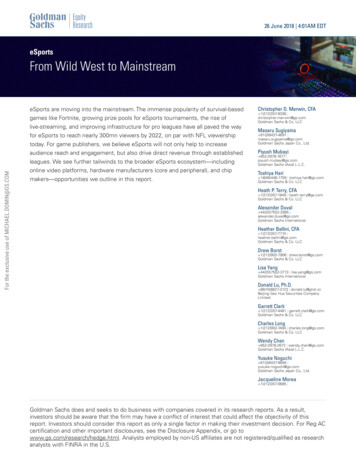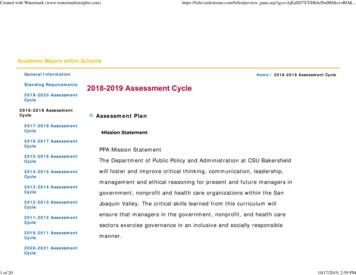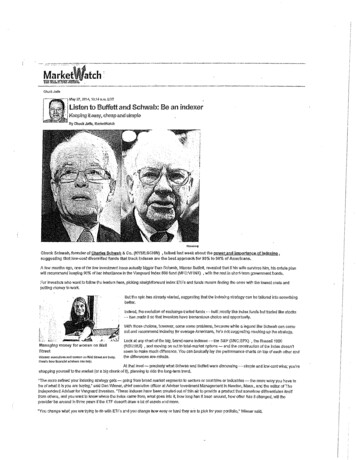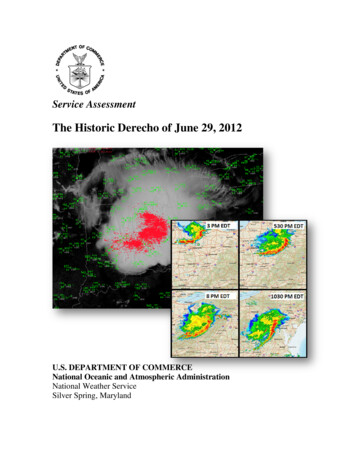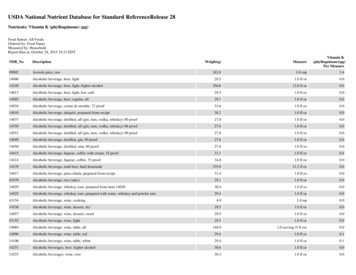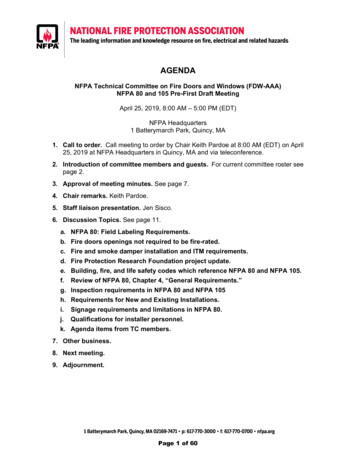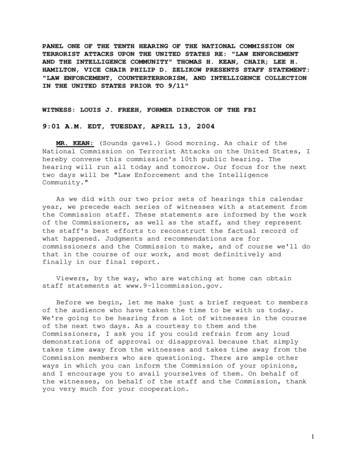
Transcription
PANEL ONE OF THE TENTH HEARING OF THE NATIONAL COMMISSION ONTERRORIST ATTACKS UPON THE UNITED STATES RE: "LAW ENFORCEMENTAND THE INTELLIGENCE COMMUNITY" THOMAS H. KEAN, CHAIR; LEE H.HAMILTON, VICE CHAIR PHILIP D. ZELIKOW PRESENTS STAFF STATEMENT:"LAW ENFORCEMENT, COUNTERTERRORISM, AND INTELLIGENCE COLLECTIONIN THE UNITED STATES PRIOR TO 9/11"WITNESS: LOUIS J. FREEH, FORMER DIRECTOR OF THE FBI9:01 A.M. EDT, TUESDAY, APRIL 13, 2004MR. KEAN: (Sounds gavel.) Good morning. As chair of theNational Commission on Terrorist Attacks on the United States, Ihereby convene this commission's 10th public hearing. Thehearing will run all today and tomorrow. Our focus for the nexttwo days will be "Law Enforcement and the IntelligenceCommunity."As we did with our two prior sets of hearings this calendaryear, we precede each series of witnesses with a statement fromthe Commission staff. These statements are informed by the workof the Commissioners, as well as the staff, and they representthe staff's best efforts to reconstruct the factual record ofwhat happened. Judgments and recommendations are forcommissioners and the Commission to make, and of course we'll dothat in the course of our work, and most definitively andfinally in our final report.Viewers, by the way, who are watching at home can obtainstaff statements at www.9-11commission.gov.Before we begin, let me make just a brief request to membersof the audience who have taken the time to be with us today.We're going to be hearing from a lot of witnesses in the courseof the next two days. As a courtesy to them and theCommissioners, I ask you if you could refrain from any louddemonstrations of approval or disapproval because that simplytakes time away from the witnesses and takes time away from theCommission members who are questioning. There are ample otherways in which you can inform the Commission of your opinions,and I encourage you to avail yourselves of them. On behalf ofthe witnesses, on behalf of the staff and the Commission, thankyou very much for your cooperation.1
We will now hear our first staff statement. It is entitled,"Law Enforcement, Counterterrorism and Intelligence Collectionin the United States Prior to 9/11."It will be read by our executive director, Phil Zelikow, ofthe Commission staff.MR. ZELIKOW: Members of the Commission, with your help yourstaff has developed initial findings regarding law enforcementand intelligence collection in the United States prior to the9/11 attacks. These findings may help frame some of the issuesto be discussed during this hearing and inform the developmentof your judgments and recommendations.This statement reflects the results of our work so far. Weremain ready to revise our understanding of this topic as ourinvestigation progresses.This staff statement represents the collective efforts of anumber of members of our staff. Caroline Barnes, ChristineHealey, Lance Cole, Michael Jacobson, Peter Rundlet, DougGreenburg and Barbara Grewe did most of the investigative workreflected in this statement.We were fortunate in being able to build upon stronginvestigative work done by the congressional Joint Inquiry andby the Department of Justice's Office of the Inspector General.We've obtained excellent cooperation from the FBI and theDepartment of Justice, both in Washington and in six FBI fieldoffices across the United States.The role of the FBI. The FBI played the lead role in thegovernment's domestic counterterrorism strategy before September11. In the 1990s most of the FBI's energy was devoted to afterthe-fact investigations of major terrorist attacks in order todevelop criminal cases. Investigating these attacks alwaysrequired an enormous amount of resources. As most of theseattacks occurred overseas, many of the FBI's top terrorisminvestigators were deployed abroad for long periods of time.New York was the office of origin for the al Qaeda program,and consequently where most of the FBI's institutional knowledgeon al Qaeda resided. Working closely with the U.S. Attorney forthe Southern District of New York, the Justice Department andthe U.S. intelligence community, the FBI's New York field officewas often successful in these investigations. Many of theperpetrators of these plots were identified, arrested,2
prosecuted and convicted. These were episodes such as the WorldTrade Center bombing, the Landmarks plot, the Manila airlinesplot, the Khobar Towers bombing, the East Africa embassybombings, the Millennium plot and the U.S.S. Cole bombing.Going to the top of page 3 of the statement.The approach to counterterrorism. The FBI took a traditionallaw enforcement approach to counterterrorism. Its agents weretrained to build cases. Its management was deliberatelydecentralized to empower the individual field offices and theagents in the street. The Bureau rewarded agents based onstatistics reflecting arrests, indictments and prosecutions.As a result, fields such as counterterrorism andcounterintelligence, where investigations generally result infewer prosecutions, were viewed as backwaters. Agents developedinformation in support of their own cases, not as part of abroader, more strategic effort.Given the poor state of the FBI's information systems, fieldagents usually did not know what investigations agents in theirown office, let alone in other field offices, were working on.Nor did analysts have easy access to this information. As aresult, it was almost impossible to develop an understanding ofthe threat from a particular international terrorist group.Agents also investigated their individual cases with theknowledge that any case information recorded on paper and storedin case files was potentially discoverable in court. Thus, therewas a disincentive to share information, even with other FBIagents and analysts. Analysts were discouraged from producingwritten assessments which could be discoverable and used toattack the prosecution's case at trial.In the investigative arena, the field office had primacy.Counterterrorism investigations were run by the field, notheadquarters. Moreover, the field office that initiated a casemaintained control over it, an approach the FBI called the"Office of Origin Model." This decentralized managementstructure allowed field offices to set their own priorities,with little direction from headquarters.Management priorities and challenges. The FBI determinedearly on in the 1990s that a preventive posture was a better wayto counter the growing threat from international terrorism. Inits first budget request to Congress after the 1993 World Trade3
Center bombing, the FBI stated that, "merely solving this typeof crime is not enough; it is equally important that the FBIthwart terrorism before such acts can be perpetrated."By the late 1990s the FBI recognized that certain limitationsundermined a preventive counterterrorism strategy and itinitiated several significant reforms. Yet the FBI's leadershipconfronted two fundamental challenges in countering terrorism.First, the FBI had to reconcile this new priority with itsexisting agenda. This immediately required choices about whetherto divert experienced agents or scarce resources from criminalor other investigative or intelligence work to terrorism. As theterrorism danger grew, Director Freeh faced the choice ofwhether to lower the priority the FBI attached to work ongeneral crime, including the war on drugs, and allocate theseresources to terrorism.The Department of Justice inspector general found that whenthe FBI designated national and economic security as its toppriority in 1998, it did not shift its human resourcesaccordingly. Although the FBI's counterterrorism budget tripledduring the mid-1990s, FBI counterterrorism spending remainedrelatively constant between fiscal years 1998 and 2001. Theinspector general stated that before 9/11, the Bureau devotedsignificantly more special agent resources to traditional lawenforcement activities, such as white collar crime, organizedcrime, drug and violent crime investigations, than to domesticand international terrorism issues. According to anotherexternal review, there were twice as many agents devoted to drugenforcement matters as to counterterrorism. On September 11th,2001, only about 6 percent of FBI's total personnel worked oncounterterrorism.Former FBI officials told us that prior to 9/11, there wasnot sufficient national commitment or political will to dedicatethe necessary resources to counterterrorism. Specifically, theybelieved that neither Congress nor the Office of Management andBudget fully understood the FBI's counterterrorism resourceneeds, nor did the FBI receive all it requested from theDepartment of Justice under Attorney General Janet Reno.Reno told us that the Bureau never seemed to have sufficientresources, given the broad scope of its responsibilities. Shesaid, in light of the appropriations FBI received, it needed toprioritize and put counterterrorism first. She also said thatDirector Freeh seemed unwilling to shift resources to terrorism4
from other areas, such as violent crime. Freeh said it wasdifficult to tell field executives they needed to do additionalcounterterrorism work without additional resources.Finally, even though the number of agents devoted tocounterterrorism was limited, they were not always fullyutilized in the field offices. We learned through our interviewsthat prior to 9/11, field agents often were diverted fromcounterterrorism or other intelligence work, in order to covermajor criminal cases.The second core challenge was a legal issue that became amanagement challenge as well. Certain provisions of federal lawhad been interpreted to limit communication between agentsconducting intelligence investigations and the criminalprosecution units of the Department of Justice. This was done sothat the broad powers for gathering intelligence would not beseized upon by prosecutors trying to make a criminal case. Theseparation of intelligence from criminal investigations becameknown as "the wall."New procedures issued by Attorney General Reno in 1995required the FBI to notify prosecutors “when facts andcircumstances are developed in a foreign intelligence orcounterintelligence investigation that reasonably indicate asignificant federal crime has been, is being or may becommitted.” The procedures, however, prohibited the prosecutorsfrom, quote, "directing or controlling," close quote, theintelligence investigation.Over time, the wall requirement came to be interpreted by theJustice Department and particularly the Foreign IntelligenceSurveillance Court as imposing an increasingly stringent barrierto communications between FBI intelligence agents and criminalprosecutors.Despite additional guidance on information sharing issued byAttorney General Reno in February 2000, and by Deputy AttorneyGeneral Larry Thompson in August, 2001, the wall remained asource of considerable frustration and concern within theJustice Department. Justice Department prosecutors and FBIcriminal agents were responsible for large criminal cases likethe embassy bombings. The intelligence side of the FBI, though,had the legal tools essential for domestic intelligence work,such as FISA surveillance. In this environment, domesticcounterterrorism efforts were impaired.5
Attempts at reform. There were attempts at reform. Start withthe 1998 Strategic Plan. The FBI issued a five-year strategicplan in May, 1998, spearheaded by Deputy Director Robert Bryant.The plan mandated development of a strong intelligence base,including human sources, intelligence collection and reportingrequirements. As a result of the strategic plan, the FBI createdan Office of Intelligence that was superseded by a newInvestigative Services Division created in 1999. That divisionwas intended to strengthen the FBI's strategic analysiscapability across the spectrum of traditional criminal,counterintelligence and counterterrorism cases. Thus, for thefirst time, the strategic analysis function was made independentof the operational divisions.The Investigative Services Division also was intended toincrease the professional stature of analysts. An internalreview of the FBI's intelligence analysis function at the timefound that 66 percent of the Bureau's analysts were notqualified to perform analytical duties. The review maderecommendations for improvements. It appears that theserecommendations were either not implemented or not enforced. Thenew division did not succeed. FBI officials told us that it didnot receive sufficient resources, and there was ongoingresistance to its creation from the senior managers in the FBI'soperational divisions. Those managers feared losing control,they feared losing resources, they feared they would be unableto get the assistance they wanted from the new division'sanalysts. Director Robert Mueller dismantled the division soonafter the 9/11 attacks. We will discuss his changes in StaffStatement No. 12.The Counterterrorism Division and MAXCAP 05. In 1999, the FBIalso created separate Counterterrorism and CounterintelligenceDivisions to ensure enough focus on these missions.By late 1999, Dale Watson, the first head of the newCounterterrorism Division, recognized the urgent need to elevatethe counterterrorism capacity of the FBI organization-wide. Hedeveloped the strategy he called MAXCAP 05. His goal was thatthe Bureau reach its maximum feasible capacity incounterterrorism by 2005 through a strategy focused onintelligence gathering, valid and straightforward reporting andtracking mechanisms, effective interagency liaison andcooperation, and accountable program management.During July and August of 2000, at four regional conferences,Counterterrorism Division leadership presented the new strategy6
to all of the FBI's assistant directors and special agents incharge of the FBI's 56 field offices. Field executives toldWatson they did not have the analysts, linguists or technicallytrained experts to carry out the strategy. Watson asked for helpfrom the Training Division and the new Investigative ServicesDivision. Watson told us that trying to implement this strategywas the hardest thing he had ever done in his life.One year after the regional conferences, almost every FBIfield office's counterterrorism program was assessed to beoperating at far below maximum capacity. Watson thought the FBIhad to step up to a major choice of mission, perhaps turningover a significant share of narcotics enforcement to the DEA inorder to free up resources for countering terrorism. Although hethought FBI director Freeh was sympathetic, most FBI managersopposed such a fundamental change before 9/11, and none of thepre-9/11 budgets made that choice.The FBI's new counterterrorism strategy was not a focus ofthe Justice Department in 2001. Attorney General Ashcroft toldus that upon his arrival at the department, he faced a number ofchallenges that signaled the need for reform at the FBI. Hementioned the Ruby Ridge and Waco incidents, the Wen Ho Leeinvestigation, FBI agent Robert Hanssen's espionage, the latediscovery of FBI documents related to the Timothy McVeigh case,and public disclosures about lost laptops and firearms.The new Bush administration proposed an 8 percent increase inoverall FBI funding for fiscal year 2002. This included thelargest proposed percentage increase in the FBI'scounterterrorism program since fiscal year 1997. On May 9, 2001,Attorney General John Ashcroft testified at a hearing on U.S.efforts to combat terrorism. He testified that the JusticeDepartment had no higher priority than to protect citizens fromterrorist attacks.On May 10th, the department issued guidance for developingthe fiscal year 2003 budget that made reducing the incidence ofgun violence and reducing the trafficking of illegal drugspriority objectives. Watson told us that he almost fell out ofhis chair when he saw the memo, because it made no mention ofcounterterrorism. The department prepared a budget for fiscalyear 2003 that did not increase counterterrorism funding overits pending proposal for fiscal year 2002. It did include anenhancement for the FBI's information technology programintended to support the collection, analysis and rapiddissemination of information pertinent to FBI investigations.7
Acting FBI Director Thomas Pickard told us he made an appealto Attorney General Ashcroft for further counterterrorismenhancements not included in this budget proposal. On September10th, the attorney general rejected that appeal.Despite recognition by the FBI of the growing terroristthreat, it was still hobbled by significant deficiencies. Someof those deficiencies were, for instance, in intelligencecollection. Intelligence collection efforts should begin with astrategy to comprehend what is being collected, identify thegaps, and push efforts toward meeting requirements identified bystrategic analysis. Prior to 9/11 the FBI did not have a processin place to manage its collection efforts effectively. It didnot identify intelligence gaps. Collection of usefulintelligence from human sources was limited. By the mid-1990ssenior managers were concerned the Bureau's statistically-drivenperformance system was resulting in a roster of mediocresources.The wall between criminal and intelligence investigationapparently caused agents to be less aggressive than they mightotherwise have been in pursuing Foreign IntelligenceSurveillance Act (FISA) surveillance powers in counterterrorisminvestigations. Moreover, the FISA approval process involvedmultiple levels of review, which also discouraged agents fromusing such surveillance. Many agents told us that the processfor getting these FISA packages approved was incredibly lengthyand inefficient. Several agents added that, prior to 9/11, FISAderived intelligence information was not fully exploited anyway,but was collected primarily to justify continuing thesurveillance.The FBI did not dedicate sufficient resources to thesurveillance or translation needs of counterterrorism agents.Surveillance personnel were more focused on counterintelligenceand drug cases. Many field offices did not have surveillancesquads before 9/11. Similarly, the FBI did not have a sufficientnumber of translators proficient in Arabic and other languagesuseful in counterterrorism investigations, and that resulted ina significant backlog of untranslated FISA intercepts by early'01.FBI agents received very little formalized training in thecounterterrorism discipline. Only three days of the 16-week newagents course were devoted to national security matters of anykind, counterterrorism or counterintelligence, and most8
subsequent counterterrorism training was received on an ad hocbasis or on the job.Additionally, the career path for agents necessitatedrotations between headquarters and the field in a variety ofwork areas, making it difficult for agents to develop expertisein any particular area, especially counterterrorism orcounterintelligence.We were told that very few field managers of the FBI had anycounterterrorism experience, and thus either were not focused onthe issue or did not have the expertise to run an effectiveprogram.Finally, agents' investigative activities were governed byAttorney General Guidelines, first put in place in 1976, the socalled Levy Guidelines, and revised in 1995, to guard againstmisuse of government power. The guidelines limited theinvestigative methods and techniques available to agentsconducting preliminary investigations of potential terroristactivities or connections. They prohibited the use of publiclyavailable source information, such as that found on theInternet, unless specified criteria were present. Theserestrictions may have had the unintended consequence of causingagents to even avoid legitimate investigative activity thatmight conceivably be viewed as infringing on religious libertiesor lawful political protest. Agents we interviewed believedthese limitations were too restrictive and adversely affectedtheir intelligence investigations.Strategic Analysis. It is the role of the strategic analystto look across individual operations and cases to identifytrends in terrorist activity and develop broad assessments ofthe terrorist threat to U.S. interests. The goal is notabstract. Such analysis drives collection efforts. It is theonly way to evaluate what the institution does not know. The FBIhad little understanding of, or appreciation for, the role ofstrategic analysis in driving investigations or allocatingresources.The role of the tactical analyst, on the other hand, isgeared toward providing direct support to investigations. Agentsviewed tactical analysts as performing duties that advancedtheir cases. They failed to see the value of strategic analysis,finding it too academic and therefore irrelevant. Creation ofthe ill-fated Investigative Services Division may even have9
worsened this attitude by distancing strategic analysts fromagents in the operational divisions.Moreover, strategic analysts had difficulty getting access tothe FBI and intelligence community information they wereexpected to analyze. The poor state of the FBI's informationsystems meant that analysts' access to information depended inlarge part on their personal relationships with individuals inthe units or squads where the information resided. In short,analysts didn't know what they didn't know. As a result, priorto 9/11 relatively few strategic counterterrorism analyticalproducts had been completed. Indeed, the FBI had never completedan assessment of the terrorist threat to the U.S. homeland.According to the Department of Justice inspector general, FBIofficials were comfortable relying on their individualprofessional judgment regarding the terrorist threat and, quote,"did not value a formal written assessment that uses astructured methodology," close quote.Compounding this situation was the FBI's tradition of hiringanalysts from within the agency, rather than recruitingindividuals with the relevant educational background andexpertise. In our field visits, we encountered severalsituations in which poorly qualified administrative personnelwere promoted to analyst positions as a reward for goodperformance in other positions. When the FBI hired or promotedpeople with appropriate analytical skills, the Bureau's lack ofa long-term career path and a professional training programcaused many capable individuals to leave the Bureau or moveinternally to other positions.In addition, managers often did not use qualified analystseffectively, especially in the field. Some field analysts weinterviewed told us they were viewed as "über-secretaries,"expected to perform any duty that was deemed non-investigative,including data entry and answering phones. Headquarters managersoften did not have sufficient staff support, so they too turnedto analysts to perform policy-oriented and programmatic dutiesthat were not analytic in nature.Knowledge management. Prior to 9/11, the FBI did not have anadequate ability to know what it knew. In other words, the FBIdid not have an mechanism for effectively capturing or sharingits institutional knowledge. FBI agents did create records ofinterviews and other investigative efforts, but there were noreports officers to condense the information into meaningfulintelligence that could then be retrieved and disseminated.10
The FBI's private primary information management system,using 1980s technology already obsolete when installed in 1995,limited the Bureau's ability to share its information internallyand externally. The FBI did not have an effective system forstoring, searching or retrieving information of intelligencevalue contained in its investigative files.Director Freeh told us that he went before congressionalstaff and members twice a year "begging and screaming" for fundsto improve the FBI's information technology infrastructure.Former Department of Justice and FBI officials told us that theFBI lacked personnel with the necessary expertise leading itsinformation technology improvement efforts, increasing Congress'reluctance to support funding proposals in this area.Once Freeh brought former 30-year IBM executive Robert Dieson board in 2000, the Bureau developed a comprehensive IT planthat Congress did support. The FBI received congressionalapproval in late 2000 for the Trilogy project, a 36-month planfor improving its networks, systems and software. Dies told usthat given the enormity of the task at hand, his goal was merelyto "get the car out of the ditch." As of September 2001, theproject was under way but by no means fully implemented.The FBI's Joint Terrorism Task Forces, JTTFs, were theprimary mechanism for sharing counterterrorism information withother law enforcement agencies in the field. The FBI expandedthe number of JTTFs throughout the 1990s; by 9/11 there were 35.The JTTFs, while useful, had limitations. They set their ownpriorities in accordance with regional and field officeconcerns; most were not fully staffed. Many state and localentities believed they would gain little from having arepresentative on a JTTF. Most detailees were mainly there asliaison rather than as full working members of the JTTFs, andmany did not have access either to FBI information systems ortheir own home agency systems while in the FBI workspace.Moreover, the supervisors in their home agency chains of commandoften did not have security clearances, making it difficult toshare important intelligence information.We were told that at headquarters, information sharingbetween the FBI and CIA improved greatly when the agencies beganexchanging senior counterterrorism officials in 1996. Afterserving on rotation, they understood each other's agencies andmissions better than they had before. But as will be discussedin the next staff statement, there were other problems with11
information sharing between the FBI and the CIA. The FBI'sunwillingness or inability to share information reportedlyfrustrated the White House national security officials. RichardClarke told us that the National Security Council never receivedanything in writing from the FBI whatsoever. Former DeputyNational Security Advisor James Steinberg said the only time theFBI gave the NSC relevant information was during the Millenniumcrisis. Clarke told us that Attorney General Reno was notifiedthe NSC could not run an effective counterterrorism programunless it had access to FBI information.The Justice Department representative on Clarke's interagencygroup, the CSG, has told us, however, that to his knowledge,neither Clarke nor anyone else at the NSC raised any systemicissue of FBI information sharing as a policy issue or a matterto be considered by Attorney General Reno. Reno, in any case,initiated biweekly briefings of National Security Advisor Bergerwith FBI Director Freeh.Reno told us that she was very concerned about the Bureau'sinformation sharing and intelligence capabilities. In 2000, shesent several memoranda to Director Freeh expressing theseconcerns. One memo stated "it is imperative that the FBIimmediately develop the capacity to fully assimilate and utilizeintelligence information currently collected and contained inFBI files and use that knowledge to work proactively to identifyand protect against emerging national security threats." Reno'srequirements included improved information sharing, improvedcounterterrorism training, a threat assessment, and a strategyto counter the threat. It is not clear what actions the FBI tookin response to these directives from the attorney general.Terrorist financing. The FBI worked hard on terroristfinancing investigations. The Bureau primarily utilized anintelligence approach. Agents in a number of field officesgathered intelligence on a significant number of suspectedterrorist financing organizations. Before 9/11, those FBIoffices had been able to gain a basic understanding of some ofthe largest and most problematic conspiracies that have sincebeen identified.The agents understood that there was a network of extremistorganizations operating in the United States supporting globalIslamic jihadi movements. They did not know the degree to whichthese extremist groups were associated with al Qaeda. It wasalso unclear whether any of these groups were sending money toal Qaeda.12
The FBI operated a web of informants, conducted electronicsurveillance, and had opened investigations in a number ofoffices. Numerous offices, including New York, Chicago, Detroit,San Diego and Minneapolis, had significant intelligenceinvestigations into groups raising money for extremists. Many ofthese groups appeared to the FBI to have some connection toeither al Qaeda or Bin Ladin.But the problems in the FBI's counterterrorism programaffected these investigations, too. The FBI was hampered by aninability to develop an endgame. Its agents continued to gatherintelligence with little hope that they would be able to make acriminal case or otherwise disrupt the operation. Agents werestymied by rules regarding the distinction between intelligenceand criminal cases, in part due to the wall then in placebetween criminal and intelligence investigations, as describedabove.Making a terrorist financing case was at least as difficult,perhaps more so, than other similarly complex internationalfinancial criminal investigations. The money inevitably movedoverseas. Once that occurred, the money was much harder totrack, and the agents were at a dead end. In addition, due tothe FBI's inadequate information management systems, strategicanalysis and information sharing capabilities before 9/11, theFBI lacked a fundamental strategic understanding of the natureand extent of the al Qaeda fundraising problem in the U.S.As a result, the FBI could not fulfill its responsibility toprovide intelligence on domestic terrorist financing topolicymakers. It did not contribute to national policycoordination on this issue. Instead, FBI agents simply kept tabson the fundraisers, even
Justice Department. Justice Department prosecutors and FBI criminal agents were responsible for large criminal cases like the embassy bombings. The intelligence side of the FBI, though, had the legal tools essential for domestic intelligence work, such as FISA surveillance. In this environment, domestic counterterrorism efforts were impaired.


